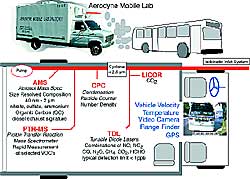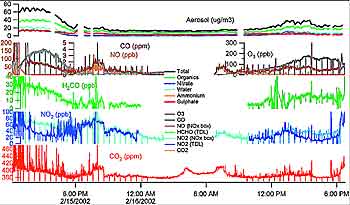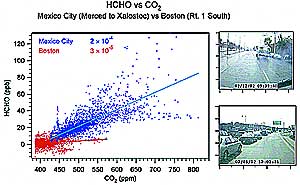 |
||
| Massachusetts Institute of Technology |
|
Integrated Program on Molina Center for Energy and the Environment Voice: (858) 657 Fax: (858) 657- E-mail: info@mce2.org |
Exploratory Field Measurement Campaign in the MCMA
A series of exploratory mobile and fixed-site field measurements, funded by the Comisión Ambiental Metropolitana (CAM) and coordinated by Dr. Luisa Molina, were performed during February 2002, and an intensive five-week field measurement campaign is scheduled to run from late March through early May of 2003. The campaign was conducted utilizing a mobile laboratory developed at Aerodyne Research, Inc. (ARI) and equipped with a range of realtime particle and trace gas diagnostics, as well as various other instruments from Washington State University (WSU), Montana State University (MSU), and the Massachusetts Institute of Technology. The Mexican field measurement team included scientists from the Mexican Petroleum Institute (IMP), National University of Mexico (UNAM), Metropolitan University (UAM-I, UAM-A), National Institute of Public Health (INSP), as well as investigators from Mexican government agencies involved in air quality in the MCMA—Federal Ministry of the Environment and National Resources (SEMARNAT), Secretary of the Environment of the Government of the Federal District (SMA-GDF), and the Secretary of Ecology of the State of Mexico. The layout for the ARI Mobile Laboratory, as deployed in Mexico City last February, is shown in Figure 1. Realtime measurements of selected trace gases were provided by ARI’s tunable infrared laser differential absorption spectroscopy (TILDAS) instruments using lead salt diode lasers. Fast response fine aerosol size distributions (40–2000 nm) and non-refractory chemical composition were measured with a novel aerosol mass spectrometer (AMS) designed and built at ARI. Fixed site rapid response measurements of selected aromatic and partially oxygenated VOCs were provided by a proton transfer reaction mass spectrometer (PTR-MS) operated by MSU. A commercial LICOR non-dispersive infrared (NDIR) unit provides realtime CO2 measurements and a commercial TSI condensation particle counter (CPC) provides realtime total number densities for particles with diameters between 10 and 1000 nm. Commercial air quality monitors for NO/NO2, CO and O3 supplied by WSU were also included. Ultraviolet (UV) solar flux was recorded by an Epply total UV radiometer. WSU collected VOC whole air samples at selected sampling points within the urban area using portable canister samplers. During the exploratory field measurement campaign the mobile lab operated in three modes: First, stationary deployments at selected RAMA monitoring sites were used to measure diurnal pollution levels in various sectors of the MCMA and to provide high time resolution research instrument data for selected pollutants to help validate and amplify data from the monitoring instruments. Second, mobile measurements were made through selected city sectors to map ambient pollutant levels, and sample and characterize mobile and fixed site emission plumes. Finally, dedicated chase experiments were mounted to be?er characterize gaseous and particulate emissions from selected classes of vehicles, including heavyduty diesel trucks, buses, and colectivos. While detailed analysis of the February 2002 data is ongoing, a sampling of findings is presented here to indicate the quality and import of the data.
Figure 2 shows a sampling of diurnal, fixed site data taken at the RAMA station on the grounds of an elementary school in Pedregal. Situated in the southwest portion of the Federal District, Pedregal receives a pollutant flow when the normal wind pattern blows southwest from the metropolitan and industrial areas. Even though the weather was not unusually hot or sunny, tremendous photochemical activity can be observed, with ozone levels exceeding 250 ppbv on the afternoon of Feb. 15, and 200 ppbv on the afternoon of Feb. 16 (gray trace in second panel from top). One key to this photochemical activity are the high levels of formaldehyde (green trace in center panel, measured with the TILDAS instrument); HCHO levels of 20 to 40 ppbv build up in the morning, preceding the photochemical oxidant peaks by several hours. Data from the core urban and industrial areas to the northwest show even higher morning HCHO buildups, even on completely cloudy mornings with no appreciable photochemical activity (in general the weather during the Feb. 2002 campaign was unusually cloudy, rainy and cool), demonstrating large emission sources for this key photochemical trigger species.
Finally, the top panel of AMS data shows a photochemical “bloom” of fine (mode peak at 400-500 nm) secondary aerosols composed primarily of ammonium nitrate, ammonium sulfate, and partially oxidized VOCs. The simultaneous early afternoon production of large concentrations of photochemical oxidants (ozone, nitrogen dioxide, organic nitrates) and secondary fine aerosol particles demonstrates how closely connected the photochemical oxidant and fine aerosol problems are in the MCMA, and suggests they will have to be dealt with in concert, not as separate issues. Data taken during transverse MCMA “mapping” activities with the mobile laboratory confirms that a significant emission source of HCHO is present and persistent. Using the fast response (1s) TILDAS and NDIR measurements, the amount of HCHO present when the mobile laboratory samples a transient CO2 plume, predominantly from mobile vehicle sources, can be evaluated. Figure 3 shows the correlation (in blue) between the concentration of CO2 and HCHO in MCMA transient plumes during one transect, while the same correlation for metropolitan Boston traffic in mid-March 2002 is shown in red. The average HCHO/CO2 ratio in the MCMA plumes is 0.0002. The exploratory MCMA field campaign also showed the utility of using the mobile laboratory in “chase” mode, where classes of motor vehicles of interest can be specifically sampled to better quantify their emissions characteristics as a function of driving cycles. In this mode a target vehicle of the desired type is followed as the mobile laboratory’s sampling probe moves in and out of its exhaust plume. MCMA-2003 Field CampaignThe MIT/CAM MCMA experimental team has committed to an intensive, five-week field campaign in the spring of 2003. The campaign’s field measurement phase is planned to extend from late March to early May and is designed to cover the height of the annual photochemical season just prior to the onset of the rainy season. This period will include measurements taken before, during, and after Holy Week (April 14-20, 2003), when vehicular traffic is historically reduced as city residents leave for the holiday. By taking measurements before, during and after this period, it is likely that a better assessment of the vehicular emissions contribution to the air quality reduction in this megacity can be assessed with regard to oxidant and aerosol levels. Unlike the February 2002 exploratory field campaign that focused primarily on mobile laboratory measurements, the 2003 campaign will also involve a highly instrumented “supersite” located at the field campaign headquarters at the National Center for Environmental Research and Training (Centro Nacional de Investigación y Capacitación Ambiental or CENICA). The fixed supersite will be enhanced by the deployment of one or two research grade differential optical analysis spectroscopy (DOAS) instruments and a research LIDAR. It will also host collaborative measurement campaigns by several US research groups, including Drs. Jeffrey Gaffney and Nancy Marley of the US Department of Energy’s (DOE) Argonne National Laboratory, and Drs. Janet Arey and Roger Atkinson of the University of California at Riverside. In addition, similar to February 2002 exploratory campaign, extensive meteorological data as well as a wide range of fixed site chemical data will be available from collaborating Mexican research groups. |



